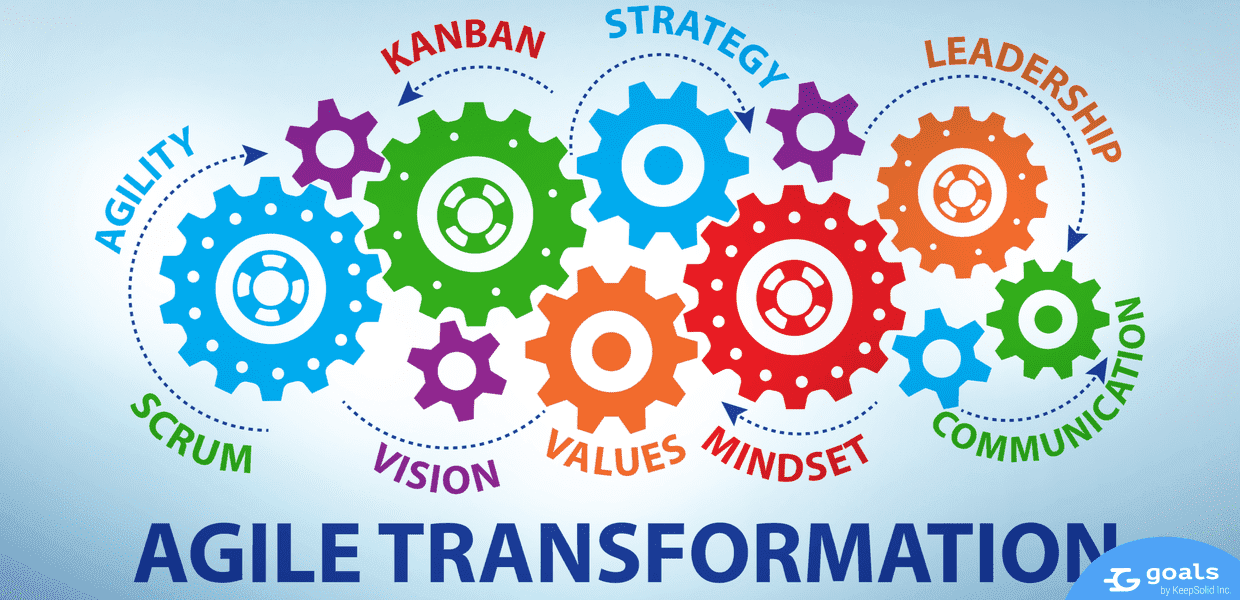What is Agile Transformation?
Agile is becoming an integral part of a successful modern business, and its transformational benefits are evident not only for software development startups, but for large organizations. Yet, for most companies moving to the Agile mindset is a major challenge that requires comprehensive change in attitudes, values, and ways of communication and coworking.

Traditional vs. Agile Organizations
To understand the way an organization needs to cover from the traditional corporate mindset to the Agile philosophy, let’s compare traditional vs. agile businesses:
Ideally, an agile organization can take the stability and efficiency of a traditional business and combine it with velocity and adaptability.
Agile transformation journey
As any paradigm shift, Agile transformation is a long-term endeavor that must be
- comprehensive in its relation to strategy processes, people and technology, and
- iterative with an allowance for readjustments and further changes.
A typical company’s journey to becoming agile covers multiple stages, and it is not linear and obstacle free:
1. Realizing the Need to Change
Most company leaders realize that agility and collaboration are key factors of the organization's success, yet so far only a fraction of businesses can be called agile. The starting point of moving to the Agile mindset is to understand the intended outcome for the organization to be able to respond to changes, renew itself and succeed in a turbulent environment.
2. Involving top management
It is possible to begin the journey with a team of Agile champions, yet it might be hard to acquire the social capital to attract broader support and there’s a high risk that, limited to enthusiasts, the Agile philosophy will die out. Therefore, it is important that the top management is eager to celebrate every success and encourage structural change throughout the organization.
3. Assessing the risks
Top management will also need to be aware of the risks and benefits of moving to Agile. In certain cases, the transformation might be postponed for several years, since the company is deemed not to be ready to change.
4. Learning to be Agile
Agile is not a stringent methodology, and an Agile transformation is not a single project, but a never-ending endeavor aimed at complex change. Talking to mentors, learning from other organizations and attending conferences of public events help Agile champions get insight and inspiration.
5. Forming a team of Agile champions
Once the company management has decided to launch the transformation, it will need to form a team that will lead the journey. This team can be formed of individuals from any division and level of the organization. Their task is to act as a group of Agile evangelists who are willing to fight for the idea and see the transformation happen.
6. Testing Agile
Any transformation must happen organically, so the company’s journey to Agile management should begin by proving the concept on several teams and testing what works for the specific organization.
7. Overcoming setbacks
Every organization that wishes to move to the Agile framework encounters setbacks and obstacles, particularly at early stages. In most cases, it requires time for the teams to be able to accept changes and regain their efficiency in the new setting.
8. Scaling up to the Agile organization
Creating individual Agile teams might be easy. Another thing is to make the organization Agile. While scaling up to cover every department and team, the vision will inevitably change and the idea of Agile will evolve to adapt to the needs of all teams throughout the company.
9. Fighting “fake Agile”
It might be tempting to treat Agile as a patch to the existing processes, or to practice it only with top talent, or take only parts that are easy to implement and that do not cost much effort. Yet, this will lead to deploying “fake Agile'' with no significant changes in the workflow and managing processes.
10. Embracing strategic agility
The major financial gains from Agile come from Strategic Agility, which is mastering the art of market-creating innovations – innovations that open up new markets that never existed before. This is the next frontier of the Agile transformation as compared to the Operational Agile, yet it is a crucial step for any company that wants not only to survive, but to thrive.
Deploying Agile is a means, not the goal. Agile transformation helps the organization create incremental value at scale and achieve financial success based on the risk-free development process, yet the organization needs to be willing to embrace the change and adjust to the present-day market turbulence.



